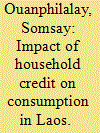| Srl | Item |
| 1 |
ID:
154536


|
|
|
|
|
| Summary/Abstract |
This study evaluates the impact of credit on consumption in Laos. A two-stage selection bias correction method based on a multinomial logit framework is used to estimate and compare the consumption of borrowing households with and without credit. The results show that compared to what household consumption would have been without credit, borrowing households tend to have higher overall consumption. However, when consumption is disaggregated into food and nonfood, it is found that only formal credit has a positive impact on food spending. Borrowing from semiformal sources and informal sources without interest has a negative impact on food spending. For nonfood consumption, the impact of credit is found to be positive and statistically significant for all credit sources.
|
|
|
|
|
|
|
|
|
|
|
|
|
|
|
|
| 2 |
ID:
187892


|
|
|
|
|
| Summary/Abstract |
Using a novel panel data method proposed by Hisao, Ching and Wan (2012), we empirically evaluate the misalignments between the actual and counterfactual values of Chinese real effective exchange rate (REER, CPI-based) from 1994 to 2020, where “counterfactual” refers to the counterfactual scenarios that some major economic events had not happened. These events include China's accession to WTO from December 2001, the reforms of exchange rate regime in July 2005, June 2010 and August 2015, China's economic stimulus package in November 2008, and the US-China trade dispute started from March 2018. We calculate the counterfactual values for both real and nominal effective exchange rates (REER and NEER) in order to examine the channels of the misalignments. We find that the reform of China's exchange rate policy in July 2005 and August 2015 increased Renminbi's trade competitiveness in real term compare to foreign currencies, while other events decreased it or had no effects. The misalignments in REER are caused by the changes in both NEER and China's CPI.
|
|
|
|
|
|
|
|
|
|
|
|
|
|
|
|